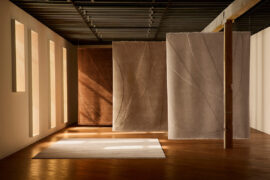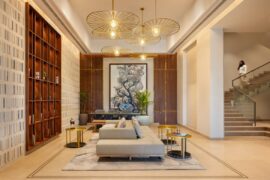As one of the many entries to The Building category at the 2024 INDE.Awards, this community centre is something out of the ordinary through its architectural design, that also provides a place for community and connection for many.

April 24th, 2024
As an architectural endeavour, the Nokha Village Community Centre is spectacular in its form and position in the landscape and it also provides a place for the local populace to gather.
Sanjay Puri Architects has created an extraordinary meeting place for all age groups, with spaces for music, talks and social interaction that brings surrounding communities together.
The Nokha Village Community Centre is located in Rajashthan, India, set amidst the arid desert landscape of Nokha in the Rohtas District of Bihar. The centre was conceived as a meeting place for the many villages within the district, but it also serves as a memorial to Padmaram Ji Kularia, a revered businessman by his family.

As Sanjay Puri, Principal Architect and lead on the project explains, “In this rapidly urbanising world where people are becoming more reclusive and interacting more with their phones, there is a need to create spaces that bring people together.
While museums and exhibitions do this, there are no spaces for a large segment of the society who cannot afford or do not have access to museums, malls and other congregational spaces.
Related: Nature’s school by Vijay Gupta Architects

The Nokha Village Community Centre addresses these needs becoming a gathering space, an event space, a learning space and a playing space for villagers and village children of the 144 villages in the Nokha district.”
The most striking feature of the project, besides the sweeping curvilinear volume, is the abundant greenery that has been included in the design. Creating a dynamic interplay for space and form, the building provides an open north-facing courtyard that becomes an open auditorium of some 2508-square-metres (27,000-square-feet) and this is the community centre’s heart.

With a modest span of 836-square-metres (9000-square-feet) the footprint of the structure is maximised by the integration of a rooftop garden. The garden, with two varying slopes, is much more than recreational space, as it offers panoramic views of the surrounding landscape where the community can gather and engage with this man-made wonder.
Within, spaces have been designed to cater to the various needs of the community with a museum dedicated to the local culture and a digital library for children that helps address the lack of educational facilities in the area. To service large gatherings a linear amenity block housing a cafeteria, toilets, stores and parking flanks the entrance at the northern side.

The building’s southern façade and most of the eastern and western sides are enveloped by a grass-covered earth berm – a strategic response to the high temperatures experienced year-round. Along with the swathes of grass, there are natural sandstone screens that enclose the elliptically designed library and significantly reduce heat gain. The screens pay deference to Rajasthani architecture and also become an aesthetic feature as they filter the light and create ever-changing shadows throughout the day.
As gardens are a rare sight in the Nokha area, with only a few large private homes able to financially support landscaping, the inclusion of the green roof brings nature to the people. As this is a place accessible by all, the sloping gradient of 1:20 makes walking or running up towards the viewing platform at the top of the garden an easy endeavour.

While this is a modern building, a veritable oasis in the desert, the architects have made a commitment to sustainability as well as function and beauty. There is rainwater harvesting and water recycling; the rooftop gardens, stone screens and strategic landscaping help mitigate heat gain; and local materials were sought and craftspeople engaged. The centre also employs local workers and so helps support the district’s economy.
Sanjay Puri Architects was established in 1992 and the practice is located in Mumbai, India. The studio is consistently recognised as being in the top 100 architects in India and has received numerous awards and accolades for its work.

Projects encompass the genre of master planning, single and multi-residential, commercial, retail, hospitality, educational and institutional sectors. The ethos of Sanjay Puri Architects is to create spaces that engage people holistically, initiate spatial relationships and foster interaction on all levels.
The Nokha Village Community Centre is certainly a singular design and is a showcase for contemporary architecture that creates a new and powerful environment for many people on multiple levels. This is a place to gather, learn, play and connect, by providing a green oasis in a desert sea.
Nokha Village Community Centre by Sanjay Puri Architects is an entry to The Building category in the 2024 INDE.Awards and proudly supported by Verasol.
Sanjay Puri Architects
sanjaypuriarchitects.com
Photography
Vinay Panjwani









INDESIGN is on instagram
Follow @indesignlive
A searchable and comprehensive guide for specifying leading products and their suppliers
Keep up to date with the latest and greatest from our industry BFF's!

London-based design duo Raw Edges have joined forces with Established & Sons and Tongue & Groove to introduce Wall to Wall – a hand-stained, “living collection” that transforms parquet flooring into a canvas of colour, pattern, and possibility.

The undeniable thread connecting Herman Miller and Knoll’s design legacies across the decades now finds its profound physical embodiment at MillerKnoll’s new Design Yard Archives.

Armadillo collaborates with Barcelona artist Carla Cascales Alimbau on Gaia, a sculptural rug collection that translates fine art into handwoven form.

The Godrej Woods Clubhouse is the jewel in the crown of a residential development in Noida, India, offering every facility curated with style and finesse by Studio IAAD.
The internet never sleeps! Here's the stuff you might have missed

CPD Live returns for its final live-presented season of 2025, bringing architects, designers, and specifiers a free opportunity to earn CPD points before the year ends. Kicking off at 9 AM AEDT, This Tuesday 14th October.

Professor of architecture, academic, television presenter and much else besides, Anthony Burke joins Timothy Alouani-Roby in Sydney for a live audience discussion about housing and his globetrotting story in architecture.